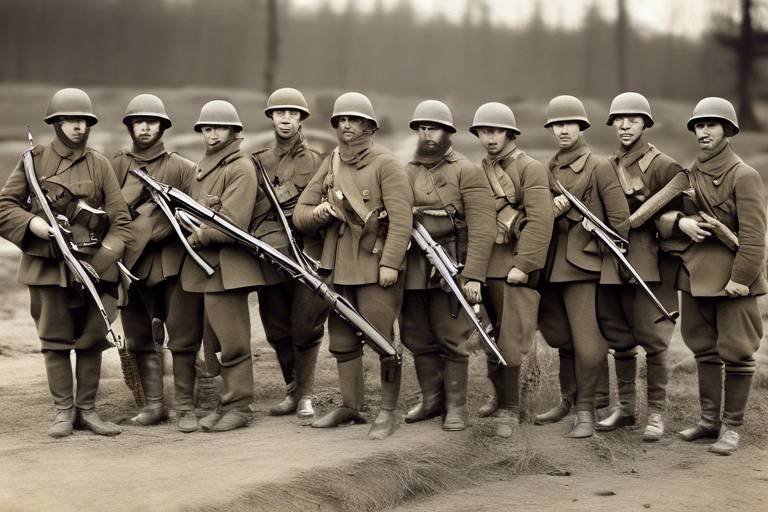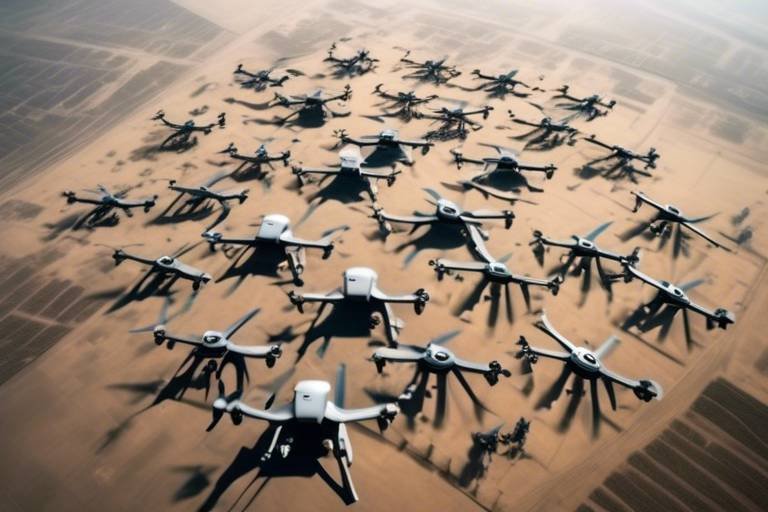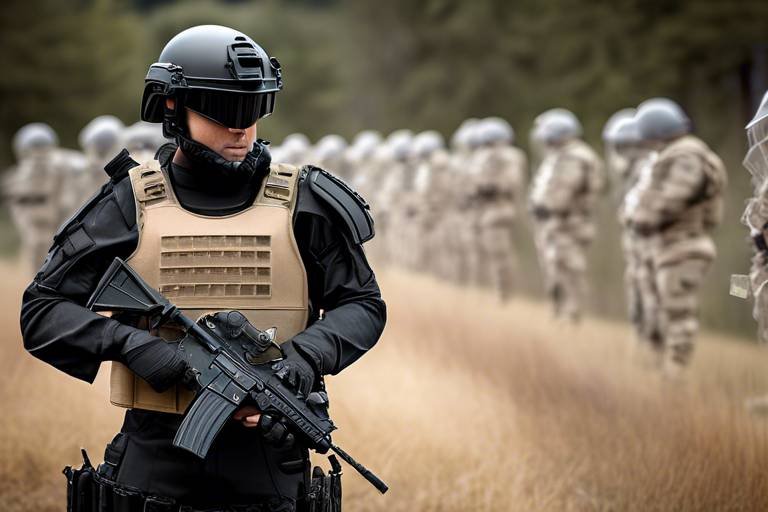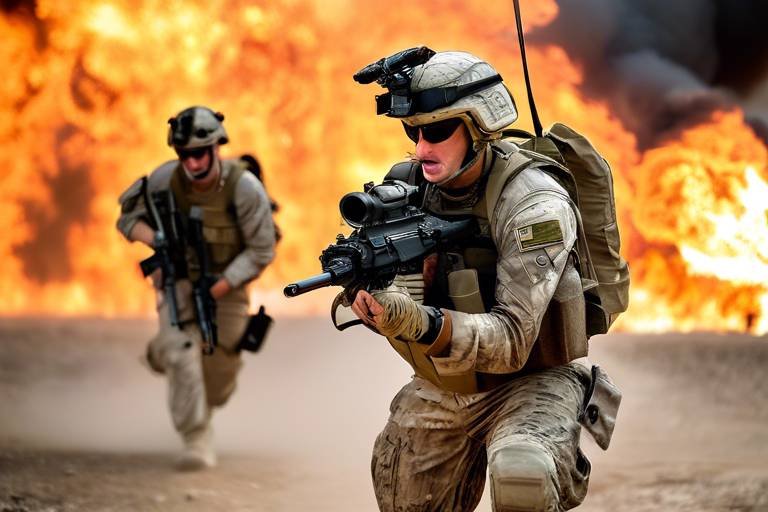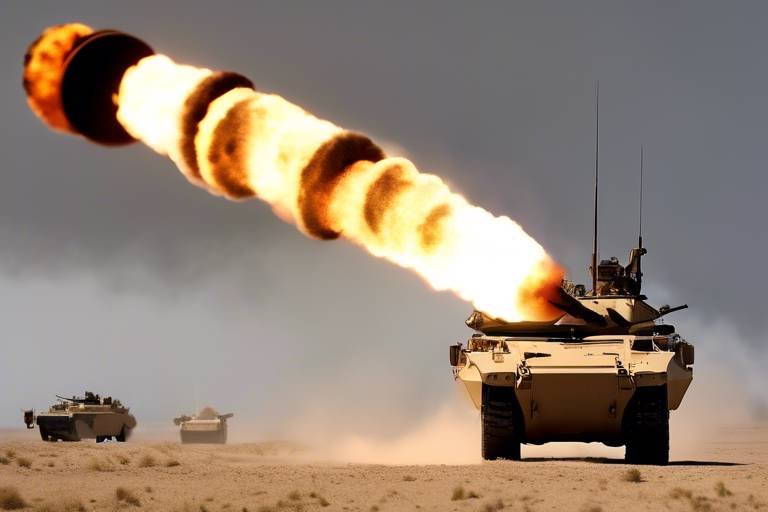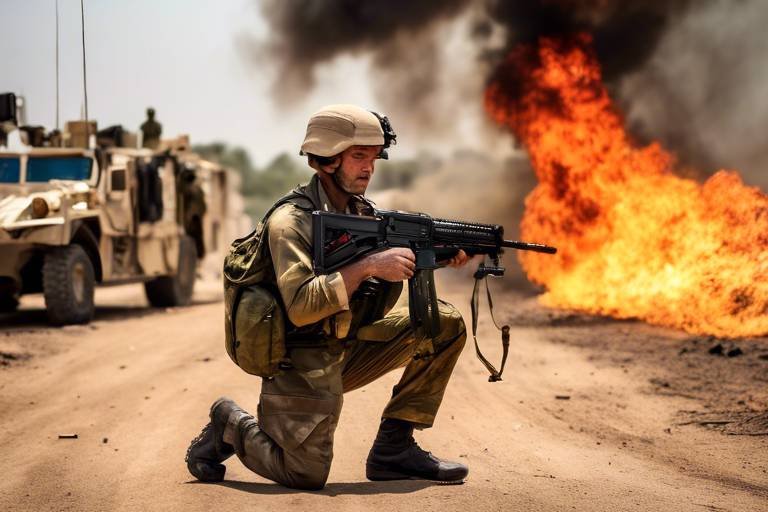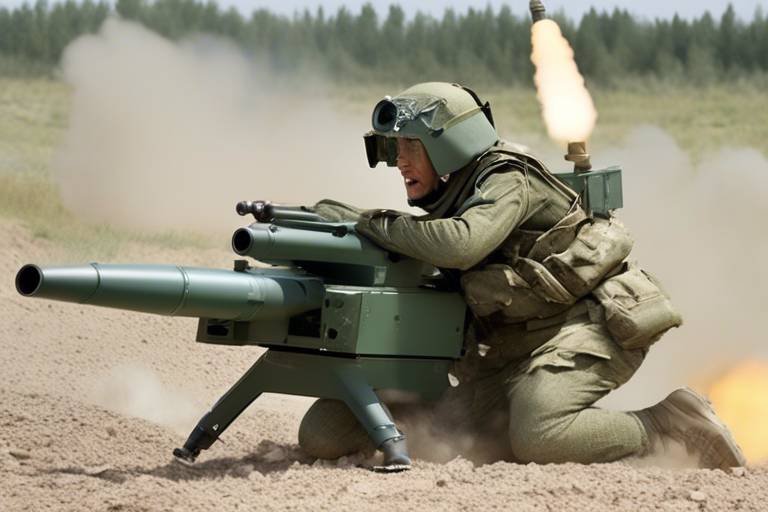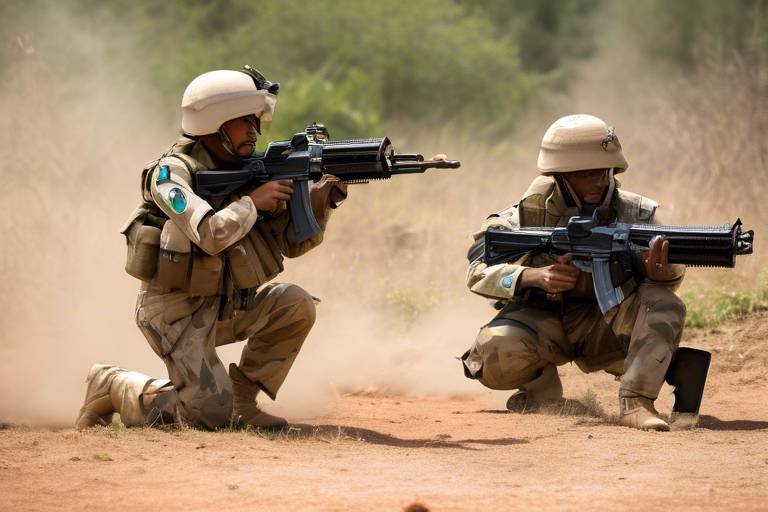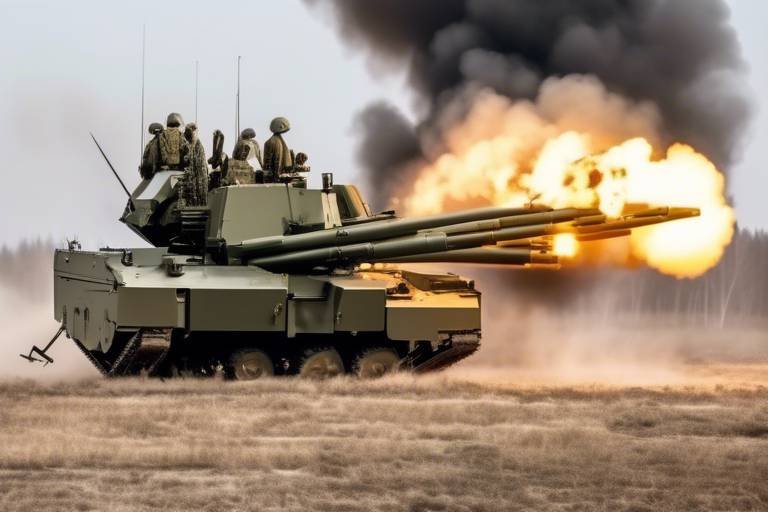The Evolution of Small Arms in Military Operations
The evolution of small arms has been a fascinating journey that reflects the changing nature of warfare and military strategy. From the rudimentary hand cannons of the Renaissance to the sophisticated, high-tech firearms used in modern combat, small arms have undergone significant transformations that have reshaped how battles are fought. Understanding this evolution not only highlights the technological advancements that have taken place but also reveals how these weapons have influenced military tactics and soldier effectiveness throughout history. Have you ever wondered how a simple tool can change the tide of war? Well, small arms have done just that, serving as the backbone of infantry forces across various conflicts.
In the early days, small arms were primarily designed for individual use, with each soldier carrying a weapon that was often slow to load and inaccurate. However, as military needs evolved, so did the design and functionality of these weapons. The introduction of rifled barrels, for example, significantly improved accuracy and range, allowing soldiers to engage enemies from a distance. This shift in capability prompted a reevaluation of battlefield tactics, as commanders began to leverage the enhanced firepower of their troops.
As we delve deeper into the historical context of small arms, it becomes clear that these weapons are not just tools of war; they are a reflection of the societies that produce them. The Industrial Revolution brought about mass production techniques that made firearms more accessible and affordable, leading to their widespread adoption in military operations. This democratization of firepower meant that even smaller nations could equip their armies with effective small arms, leveling the playing field in international conflicts.
Moreover, the impact of small arms extends beyond the battlefield. They have played a crucial role in shaping the geopolitical landscape, influencing everything from colonial expansion to modern counterinsurgency efforts. The proliferation of small arms has also raised significant ethical and legal questions, particularly in light of international arms treaties aimed at regulating their trade. As we explore the technological advancements in small arms, it is essential to consider both their military utility and the broader implications for global security.
In conclusion, the evolution of small arms is a testament to human ingenuity and the relentless pursuit of effectiveness in warfare. As we look to the future, the integration of smart technology and modular systems promises to further revolutionize small arms, potentially transforming military operations in ways we can only begin to imagine.
- What are small arms? Small arms are firearms designed for individual use, including rifles, pistols, and shotguns.
- How have small arms influenced military tactics? The development of small arms has led to changes in battlefield strategies, allowing for more effective engagement and maneuvering of troops.
- What technological advancements have impacted small arms? Key innovations include rifling, automatic loading mechanisms, and the use of advanced materials, which have improved accuracy, fire rate, and durability.
- What role do international treaties play in small arms regulation? International treaties aim to control the trade and proliferation of small arms to enhance global security and prevent conflicts.
The Historical Context of Small Arms
The evolution of small arms is a fascinating journey that intertwines with the history of warfare itself. From the moment gunpowder was discovered, the landscape of military conflict began to change dramatically. Early firearms, such as hand cannons and matchlocks, emerged during the Renaissance, marking a significant shift in how battles were fought. These primitive weapons laid the groundwork for more sophisticated designs, leading to the development of flintlocks and eventually, rifled barrels. The introduction of rifling in the 16th century was particularly revolutionary, as it allowed bullets to spin, significantly improving accuracy and range. Can you imagine how this change affected the strategies employed by military leaders at the time?
As we moved into the Industrial Revolution, the production of firearms became more efficient and standardized. This era saw the rise of mass production techniques, which made small arms more accessible to armies around the world. The introduction of breech-loading mechanisms further enhanced the effectiveness of firearms, allowing soldiers to reload faster and maintain a higher rate of fire. Such advancements not only changed the dynamics of individual combat but also transformed entire military strategies. For instance, the ability to fire multiple rounds without the need for lengthy reloading sessions meant that soldiers could engage enemies from greater distances, altering traditional tactics.
During the 19th century, the American Civil War showcased the devastating impact of small arms on the battlefield. The widespread use of rifled muskets, such as the Springfield Model 1861, resulted in staggering casualty rates, as soldiers could engage opponents effectively from hundreds of yards away. This led to a reevaluation of battlefield formations and tactics, as commanders had to adapt to the new reality of warfare where cover and concealment became paramount. The Civil War was a turning point that illustrated how small arms could dictate the pace and style of combat.
As we progressed into the 20th century, the two World Wars further highlighted the importance of small arms in military operations. The introduction of bolt-action rifles, such as the Lee-Enfield and Mauser, became the standard for infantry units. These weapons provided soldiers with reliable accuracy and firepower, which were crucial in the trenches of World War I. The effectiveness of these rifles prompted a shift in military doctrine, emphasizing the need for skilled marksmanship and the ability to engage targets at long ranges.
In summary, the historical context of small arms is not just about the weapons themselves but also about how they have shaped military strategies and tactics throughout history. The evolution from rudimentary hand cannons to sophisticated modern firearms reflects the ongoing quest for efficiency, accuracy, and lethality in combat. Each advancement in small arms technology has brought about new challenges and opportunities for military leaders, forcing them to adapt and rethink their approaches to warfare.
- What were the first small arms used in warfare? Early small arms included hand cannons and matchlocks, which emerged during the Renaissance period.
- How did rifling change small arms? Rifling allowed bullets to spin, enhancing accuracy and range, which significantly impacted military tactics.
- What role did small arms play in the American Civil War? Rifled muskets led to high casualty rates and forced a reevaluation of battlefield tactics and formations.
- How did World War I influence small arms development? The introduction of bolt-action rifles changed infantry warfare, emphasizing marksmanship and long-range engagement.
Technological Advancements in Small Arms
Throughout history, the development of small arms has been nothing short of revolutionary. The journey from primitive weapons to today's sophisticated firearms is a testament to human ingenuity and the relentless pursuit of efficiency in combat. As we delve into the technological advancements in small arms, we discover how these innovations have significantly enhanced the accuracy, rate of fire, and overall effectiveness of soldiers on the battlefield.
One of the most critical innovations in small arms technology is the introduction of rifling. This technique involves cutting grooves into the barrel of a firearm, which imparts a spin to the bullet, greatly improving its stability and accuracy over long distances. Imagine trying to throw a football without any spin; it would wobble and veer off course. Similarly, rifling allows bullets to travel straighter and farther, making it a game-changer in military engagements.
Another significant advancement is the development of automatic loading mechanisms. Early firearms required manual reloading after each shot, which could be a slow and cumbersome process during intense combat. With the introduction of automatic loading systems, soldiers could fire multiple rounds in quick succession without the need for constant manual intervention. This not only increased the rate of fire but also allowed soldiers to maintain better control during engagements, ultimately shifting the dynamics of warfare.
Additionally, the materials used in the construction of small arms have evolved dramatically. The transition from heavy wooden stocks and iron barrels to lightweight composites and alloys has made firearms more manageable and easier to carry. This is particularly crucial for modern soldiers who often find themselves in asymmetrical warfare scenarios, where mobility and speed are essential. The use of advanced materials also enhances the durability and reliability of firearms, ensuring they can withstand the rigors of combat.
To illustrate these advancements, consider the following table that highlights some key innovations in small arms technology:
| Innovation | Description | Impact on Combat |
|---|---|---|
| Rifling | Grooves in the barrel that spin the bullet for improved accuracy. | Increased effective range and precision. |
| Automatic Loading | Mechanisms that allow for quick firing without manual reloading. | Higher rate of fire and sustained firepower. |
| Lightweight Materials | Use of composites and alloys in firearm construction. | Enhanced mobility and ease of use in various combat scenarios. |
As we look at these advancements, it's clear that small arms have not only evolved in terms of design and functionality but have also transformed military strategies. The ability to engage effectively at various ranges and the capacity for rapid fire have led military leaders to rethink traditional tactics. No longer can armies rely solely on massed formations; instead, the emphasis has shifted towards individual soldier effectiveness and the integration of small arms into larger tactical frameworks.
In summary, the technological advancements in small arms have played a pivotal role in shaping modern warfare. From the precision of rifled barrels to the efficiency of automatic loading systems, each innovation has contributed to the overall effectiveness of military operations. As we continue to explore the evolution of small arms, it becomes evident that these weapons will remain a cornerstone of military strategy for years to come.
- What is rifling, and why is it important?
Rifling refers to the grooves cut into the barrel of a firearm, which spin the bullet for improved accuracy and range. - How have materials used in small arms changed?
Modern small arms utilize lightweight composites and alloys, making them easier to carry and more durable in combat. - What impact have automatic loading mechanisms had on warfare?
They have significantly increased the rate of fire, allowing soldiers to engage targets more effectively without frequent reloading.
The Role of Bolt-Action Rifles
Bolt-action rifles emerged as a game-changer in infantry warfare during the late 19th and early 20th centuries. These rifles, characterized by their manual operation mechanism, allowed soldiers to load a new cartridge into the chamber by manipulating a bolt. This simple yet effective design not only enhanced accuracy but also increased the effective range of firearms, which was crucial on the battlefields of that era. Imagine a time when soldiers relied on muzzle-loading muskets, where reloading took precious seconds; the introduction of the bolt-action rifle was akin to upgrading from a horse-drawn carriage to a high-speed train in terms of efficiency and effectiveness.
The operational mechanics of bolt-action rifles are relatively straightforward, yet they provide a level of precision that was revolutionary for their time. When a soldier operates the bolt, it ejects the spent cartridge, chambers a new round, and locks it in place, all in a matter of seconds. This streamlined process enabled marksmen to deliver accurate fire at longer distances, which was particularly advantageous in the trench warfare scenario of World War I. The combination of rifling—a technology that imparts spin to the bullet for greater stability—and the bolt-action mechanism meant that soldiers could engage targets effectively from behind cover, changing the dynamics of how battles were fought.
The influence of bolt-action rifles on military engagements during World War I cannot be overstated. As armies transitioned to trench warfare, the need for a reliable and accurate weapon became paramount. Bolt-action rifles like the British Lee-Enfield and the German Mauser became iconic symbols of their respective armies. These rifles not only provided soldiers with a sense of security but also instilled a sense of pride, as they were often seen as extensions of the soldier's own capabilities. The effectiveness of these weapons in the hands of skilled marksmen led to a shift in military tactics, emphasizing the importance of individual soldier proficiency and the role of sharpshooters in combat.
As we analyze the impact of bolt-action rifles, it’s essential to consider their legacy. Even after the introduction of semi-automatic and automatic firearms, the principles of accuracy and reliability established by bolt-action rifles continue to influence modern military designs. Today, many military and civilian rifle enthusiasts still appreciate the craftsmanship and performance of bolt-action rifles, which remain popular for hunting and target shooting.
In summary, the role of bolt-action rifles in military history is a testament to how a single innovation can transform warfare. Their introduction marked a significant turning point in military tactics, enabling soldiers to engage effectively from a distance and enhancing overall combat effectiveness. The evolution of these rifles laid the groundwork for future advancements in small arms technology, proving that sometimes, the simplest solutions can have the most profound impacts.
Impact on World War I
The introduction of bolt-action rifles during World War I marked a significant turning point in military technology and tactics. These rifles, known for their precision and reliability, transformed the battlefield dynamics, especially in the context of the brutal trench warfare that characterized the conflict. With soldiers equipped with bolt-action rifles such as the British Lee-Enfield and the German Mauser 98, the effectiveness of infantry units increased dramatically. The ability to fire accurately at long ranges with rapid follow-up shots changed how armies approached combat.
Before the widespread adoption of bolt-action rifles, infantry tactics often relied on massed formations and close-quarter engagements. However, the introduction of these rifles allowed for a shift towards more strategic positioning and the use of cover. Soldiers could engage the enemy from a distance, which necessitated new tactics to counter this advantage. As a result, military leaders had to rethink their strategies, leading to the development of new formations and the integration of machine guns to complement the firepower of infantry units.
Furthermore, the bolt-action rifle's capacity for high-velocity rounds significantly increased the lethality of infantry engagements. The ability to hit targets at distances previously thought impossible meant that soldiers could engage enemy positions while minimizing exposure to return fire. This change in dynamics not only impacted the soldiers on the front lines but also influenced the overall strategy of military campaigns. The following points illustrate the profound impact of bolt-action rifles on World War I:
- Increased Range and Accuracy: Soldiers could engage targets effectively from greater distances, which altered the traditional notions of battlefield engagement.
- Enhanced Firepower: The ability to fire multiple rounds in quick succession allowed infantry units to deliver devastating volleys against enemy forces.
- Shift in Tactics: Armies adapted their strategies to leverage the advantages provided by these rifles, leading to more complex battlefield maneuvers.
As trench warfare became the norm, the bolt-action rifle also played a critical role in the psychological aspect of combat. The sound of a rifle firing, combined with the knowledge that a skilled marksman could take out an enemy soldier from a distance, instilled both fear and respect among combatants. This psychological impact, coupled with the physical capabilities of the rifles, made them a cornerstone of military operations during the war.
In conclusion, the impact of bolt-action rifles during World War I cannot be overstated. They not only changed the way soldiers fought but also reshaped military strategies and tactics for generations to come. As armies evolved, so too did the design and function of small arms, paving the way for future innovations that would continue to influence warfare in the years ahead.
- What were the most common bolt-action rifles used in World War I? The British Lee-Enfield, German Mauser 98, and American Springfield 1903 were among the most notable.
- How did bolt-action rifles influence military tactics? They allowed for longer-range engagements and required armies to adapt their strategies to include more cover and strategic positioning.
- What role did bolt-action rifles play in trench warfare? They provided infantry with the ability to engage enemies from a distance, significantly altering the dynamics of trench combat.
Transition to Semi-Automatic and Automatic Firearms
The evolution from bolt-action rifles to semi-automatic and automatic firearms marked a revolutionary shift in infantry capabilities during the early 20th century. This transition was not merely a change in the type of weaponry used; it fundamentally altered the landscape of warfare. With the introduction of these new firearms, soldiers were no longer limited by the slow reloading processes of their predecessors. Instead, they could fire multiple rounds in quick succession, significantly increasing their combat effectiveness.
At the heart of this transformation was the semi-automatic firearm, which allowed a single pull of the trigger to discharge a round, automatically chambering the next cartridge. This innovation gave soldiers the ability to maintain a higher rate of fire without the need for manual operation. The iconic M1 Garand, for example, became a staple of the U.S. military during World War II, showcasing the advantages of semi-automatic technology. Its ability to fire eight rounds without reloading not only improved accuracy but also allowed for a more aggressive combat style. Imagine the psychological impact on the enemy when faced with a soldier who could unleash a barrage of fire without pause!
As warfare progressed, so too did the need for even more firepower. The introduction of fully automatic firearms, such as the MP40 and the M16, represented a significant leap forward. These weapons could fire continuously as long as the trigger was held down, providing soldiers with a formidable advantage in both offensive and defensive operations. The ability to lay down suppressive fire changed the dynamics of battlefield engagements, allowing infantry units to advance under cover of fire or to hold positions against overwhelming odds.
However, the transition to these advanced firearms was not without its challenges. The increased rate of fire demanded better training, as soldiers had to learn to control their weapons to avoid wasting ammunition. Additionally, the logistics of supplying these firearms became more complex. Military planners had to consider not just the weapons themselves, but also the ammunition and support needed to sustain operations. This led to a more intricate relationship between logistics and strategy in military operations.
In summary, the shift from bolt-action rifles to semi-automatic and automatic firearms was a pivotal moment in military history. It not only enhanced the effectiveness of individual soldiers but also reshaped tactics and strategies on the battlefield. As we look at modern conflicts, the legacy of this transition continues to influence how armed forces operate today, demonstrating the enduring impact of technological advancement on warfare.
- What are semi-automatic firearms? - Semi-automatic firearms are weapons that automatically chamber a new round after one is fired, allowing for rapid successive shots with each trigger pull.
- How did automatic firearms change warfare? - Automatic firearms increased the rate of fire significantly, allowing soldiers to lay down suppressive fire and change the dynamics of combat engagements.
- What are some examples of automatic firearms used in history? - Notable examples include the MP40, M16, and AK-47, each of which played crucial roles in various conflicts.
- Why is training important for using automatic firearms? - Proper training is essential to control the weapon effectively and prevent the waste of ammunition, which can be critical in combat scenarios.
Small Arms in Modern Warfare
In today's battlefield, small arms play a pivotal role in shaping military operations. As conflicts evolve, the significance of these weapons has only increased, particularly in asymmetrical warfare and urban combat scenarios. Unlike traditional large-scale engagements, modern warfare often involves irregular forces that utilize small arms to level the playing field against more technologically advanced opponents. This shift has necessitated a reevaluation of military strategies and the integration of small arms into broader operational frameworks.
Small arms, which typically include rifles, handguns, and machine guns, are crucial for infantry units. Their portability and ease of use allow soldiers to engage effectively in a variety of environments, from dense urban areas to open fields. In urban combat, for instance, the ability to maneuver swiftly and fire accurately at close range is essential. This is where the versatility of modern small arms shines, as they can be adapted for different roles, whether for stealth operations or direct assaults.
Moreover, the integration of technology into small arms has transformed their effectiveness. Features such as picatinny rails for mounting accessories, advanced optics for improved targeting, and even smart technology that enhances accuracy are becoming standard. This technological evolution allows soldiers to customize their weapons to fit specific mission requirements, thereby increasing their combat effectiveness. For example, a soldier might attach a suppressor for stealth missions or a grenade launcher for increased firepower in a firefight.
Additionally, the rise of counterinsurgency operations has further highlighted the importance of small arms in modern warfare. These operations often require a focus on winning hearts and minds, which means that soldiers must engage in close-quarters combat while minimizing civilian casualties. Small arms, particularly when used with precision, allow for this delicate balance. The training and tactics associated with their use are crucial, as soldiers are taught to engage only when necessary and to use their weapons responsibly.
As we look to the future, the ongoing advancements in small arms technology will likely continue to shape military operations. Innovations such as modular weapon systems, which allow for quick changes in configuration, and smart targeting systems that leverage AI for improved accuracy, are on the horizon. These developments will not only enhance the capabilities of soldiers but also redefine the very nature of combat itself.
In summary, small arms are not just tools of war; they are integral components of modern military strategy. Their evolution and adaptation to contemporary conflicts underscore their enduring significance on the battlefield. As military operations continue to change, the role of small arms will remain vital, ensuring that soldiers are equipped to face the challenges of modern warfare head-on.
- What are small arms? Small arms refer to firearms that can be carried and used by individual soldiers, including rifles, handguns, and machine guns.
- How have small arms evolved in modern warfare? Small arms have become more technologically advanced, incorporating features like modular designs and smart technology to enhance their effectiveness in combat.
- What role do small arms play in urban combat? They provide soldiers with the ability to engage effectively in close-quarters scenarios, adapting to the unique challenges of urban environments.
- Why are small arms important in counterinsurgency operations? Their precision and portability allow soldiers to conduct operations while minimizing civilian casualties, which is crucial in winning local support.
The Impact of International Arms Treaties
The landscape of global security is profoundly shaped by international arms treaties, which aim to regulate the trade and use of small arms. These treaties are not just bureaucratic paperwork; they represent a collective effort by nations to address the rampant proliferation of firearms that can fuel conflict and instability. The United Nations Arms Trade Treaty (ATT), established in 2013, is one of the most significant agreements in this realm, designed to promote transparency and accountability in arms transfers. But what does this really mean for military operations and global security?
Understanding the implications of these treaties requires a look at their objectives and the challenges they face. The primary goal is to prevent arms from falling into the hands of those who would misuse them, such as criminal organizations and terrorist groups. By establishing common standards for the international transfer of conventional arms, including small arms, these treaties aim to mitigate risks associated with armed violence. However, the effectiveness of such treaties often hinges on the commitment of individual nations to comply with the regulations and the political will to enforce them.
Despite the noble intentions behind these treaties, the reality is that enforcement presents a significant challenge. Countries may sign treaties but fail to implement the necessary domestic laws or regulations to control arms trade effectively. This lack of compliance can lead to a situation where the very arms that treaties aim to regulate continue to flow into conflict zones. For instance, the Small Arms Survey has reported that millions of small arms are unaccounted for worldwide, highlighting a significant gap between policy and practice.
Moreover, the impact of international arms treaties extends beyond regulation. They can also influence military strategies and operations. For example, nations that adhere to these treaties may find themselves at a disadvantage if their adversaries do not. This disparity can lead to a scenario where non-signatory countries possess more advanced or numerous weapons, thereby affecting the balance of power in various regions. Consequently, military planners must navigate a complex landscape where international norms and the realities of warfare intersect.
In addition, these treaties often spark debates about sovereignty and national security. Some nations view them as infringements on their rights to self-defense, arguing that such regulations could hinder their military capabilities. This has led to a mixed response to arms control efforts, with some countries actively participating while others remain skeptical or outright resistant. The diversity of perspectives on arms treaties reflects the complex interplay between national interests and global security concerns.
To illustrate the impact of international arms treaties, consider the following table that outlines some key treaties and their objectives:
| Treaty | Year Established | Main Objectives |
|---|---|---|
| United Nations Arms Trade Treaty (ATT) | 2013 | Regulate international trade in conventional arms, prevent illicit arms transfers |
| Convention on Certain Conventional Weapons (CCW) | 1980 | Limit the use of specific types of conventional weapons |
| Inter-American Convention Against the Illicit Manufacturing of and Trafficking in Firearms | 1997 | Combat illicit manufacturing and trafficking of firearms in the Americas |
In conclusion, while international arms treaties are crucial in promoting global security and reducing armed violence, their effectiveness is often undermined by challenges in enforcement and differing national interests. As we look to the future, the success of these treaties will depend on the commitment of nations to uphold their obligations and work collaboratively towards a safer world.
- What are international arms treaties?
International arms treaties are agreements between countries aimed at regulating the trade and use of weapons to prevent their proliferation and misuse. - Why are arms treaties important?
They help to enhance global security by establishing standards for arms transfers and reducing the risk of firearms falling into the wrong hands. - What challenges do these treaties face?
Challenges include lack of compliance, enforcement difficulties, and differing national interests regarding sovereignty and security. - How do arms treaties impact military operations?
They can influence military strategies and capabilities, especially if some nations adhere to treaties while others do not.
Challenges in Implementation
The implementation of international arms treaties presents a myriad of challenges that can undermine their effectiveness. While these treaties aim to regulate the trade and use of small arms, various factors complicate their enforcement. One of the primary issues is the lack of uniformity among nations regarding arms regulations. Countries differ significantly in their legal frameworks, cultural attitudes towards firearms, and the political will to comply with international standards. This inconsistency can lead to loopholes that are exploited by arms traffickers and non-state actors.
Moreover, the proliferation of small arms in conflict zones exacerbates the situation. In many regions, local militias and insurgent groups acquire weapons through illicit channels, often bypassing the regulations set forth by international agreements. The sheer volume of small arms in circulation makes it challenging to monitor and control their distribution effectively. For instance, it is estimated that there are over 1 billion small arms worldwide, with a significant proportion unaccounted for or in the hands of unauthorized users.
Another significant challenge lies in the enforcement mechanisms of these treaties. Many international agreements lack robust enforcement provisions, relying instead on voluntary compliance from states. This can lead to situations where countries sign treaties but fail to take the necessary steps to implement them domestically. In essence, the treaties become little more than symbolic gestures without the political will or resources to follow through. Additionally, the complexities of international law often slow down the processes needed to address violations, leaving gaps that can be exploited by those seeking to circumvent regulations.
To illustrate the challenges in implementation, consider the following table that outlines key issues faced by international arms treaties:
| Challenge | Description |
|---|---|
| Lack of Uniformity | Different legal frameworks and cultural attitudes towards firearms across nations. |
| Illicit Trafficking | Arms proliferation in conflict zones through illegal channels. |
| Weak Enforcement | Limited mechanisms for enforcing compliance with international treaties. |
| Political Will | Inconsistent commitment from states to adhere to treaty obligations. |
Furthermore, the ongoing conflicts in various regions of the world highlight the difficulties in controlling small arms. For instance, in areas like the Middle East and parts of Africa, the presence of armed groups complicates the enforcement of arms treaties. These groups often operate outside the purview of international law, making it nearly impossible to regulate their access to weapons. This situation leads to a vicious cycle where the availability of small arms fuels violence, which in turn perpetuates instability and further complicates the implementation of arms control measures.
In conclusion, while international arms treaties are essential for promoting global security, their implementation faces significant hurdles. Addressing these challenges requires a concerted effort from the international community, including strengthening enforcement mechanisms, fostering political commitment, and enhancing cooperation among nations. Only through a unified approach can we hope to mitigate the risks associated with small arms proliferation and create a safer world.
- What are small arms? Small arms refer to firearms that are designed for individual use, including handguns, rifles, and shotguns.
- Why are international arms treaties important? They help regulate the trade and use of weapons, aiming to reduce violence and promote global security.
- What challenges do these treaties face? Key challenges include lack of uniformity among nations, illicit trafficking, weak enforcement mechanisms, and inconsistent political will.
- How can these challenges be addressed? By strengthening enforcement, fostering international cooperation, and enhancing political commitment among nations.
The Future of Small Arms
The landscape of military operations is continually evolving, and small arms are no exception. As we look toward the future, emerging technologies are set to redefine the capabilities and functionalities of small arms. Imagine a world where soldiers are equipped with smart firearms that can communicate with other devices, enhance targeting accuracy, and reduce collateral damage. This isn't just a dream; it's becoming a reality.
One of the most exciting developments in small arms technology is the integration of modular systems. These systems allow for customization and adaptability, enabling soldiers to modify their weapons based on mission requirements. For instance, a soldier could switch from a standard rifle configuration to a compact version suitable for urban warfare in minutes. This flexibility can significantly enhance operational effectiveness and soldier survivability.
Moreover, advancements in materials science are paving the way for lighter, stronger, and more durable firearms. Composite materials and advanced polymers are being utilized to create weapons that reduce fatigue during prolonged engagements. Imagine carrying a weapon that feels almost weightless yet can withstand the rigors of combat. This shift not only improves soldier performance but also enhances maneuverability in diverse environments.
Another significant trend is the rise of smart technology. Firearms equipped with sensors and artificial intelligence could provide real-time data analysis, allowing soldiers to make informed decisions on the battlefield. For example, a smart rifle could assess wind conditions, distance to target, and even predict bullet drop, ensuring higher accuracy with every shot. Such innovations could drastically change the dynamics of combat, making engagements more efficient and less reliant on sheer firepower.
However, with these advancements come challenges. The integration of technology into small arms raises questions about security and ethics. As weapons become more sophisticated, the risk of them falling into the wrong hands increases. There will be a pressing need for robust regulations and oversight to ensure that these powerful tools are used responsibly and ethically.
Furthermore, the future of small arms will also be shaped by the ongoing international arms treaties and agreements. As nations strive for peace and stability, the proliferation of advanced weaponry must be managed carefully. The balance between innovation and regulation will be crucial in ensuring that military advancements do not exacerbate global tensions.
In conclusion, the future of small arms promises to be both thrilling and complex. As we continue to innovate, the military landscape will transform, presenting new opportunities and challenges. The key will be to harness these advancements responsibly, ensuring that they enhance, rather than hinder, global security and peace.
- What are modular systems in small arms? Modular systems allow soldiers to customize their weapons for different missions, enhancing flexibility and operational effectiveness.
- How does smart technology improve small arms? Smart technology can provide real-time data and analytics, improving accuracy and decision-making on the battlefield.
- What materials are being used in future small arms? Advanced materials, including composites and polymers, are being used to create lighter and more durable firearms.
- What challenges come with advanced small arms technology? The main challenges include security risks, ethical considerations, and the need for effective regulation to prevent misuse.
Frequently Asked Questions
- What are small arms?
Small arms are lightweight firearms designed for individual use. They include weapons like rifles, pistols, and shotguns. These weapons have played a crucial role in military operations and are often the primary armament for soldiers on the battlefield.
- How have small arms evolved over time?
The evolution of small arms has been marked by significant technological advancements. From early matchlocks to modern automatic firearms, innovations such as rifling and automatic loading have greatly improved accuracy, rate of fire, and overall effectiveness in combat scenarios.
- What was the impact of bolt-action rifles in warfare?
Bolt-action rifles revolutionized infantry tactics during the late 19th and early 20th centuries. Their design allowed for greater accuracy and range, significantly affecting military engagements, especially during World War I, where trench warfare became prevalent.
- How did the transition to semi-automatic and automatic firearms change combat?
The shift to semi-automatic and fully automatic firearms marked a pivotal moment in military history. These weapons increased the firepower of infantry units, allowing soldiers to engage enemies more effectively, leading to changes in combat strategies and tactics.
- What role do small arms play in modern warfare?
In contemporary military operations, small arms are essential for various combat scenarios, including asymmetrical warfare and counterinsurgency. Their versatility allows soldiers to adapt to urban combat environments and engage effectively in diverse situations.
- What are the implications of international arms treaties?
International arms treaties aim to regulate the trade and use of small arms to enhance global security. These agreements seek to prevent the proliferation of weapons and their potential use in conflicts, although enforcement can be challenging.
- What challenges exist in implementing arms treaties?
Despite the existence of international arms treaties, challenges such as differing national laws, lack of resources, and political will can hinder effective implementation. This creates difficulties in regulating small arms proliferation in conflict zones.
- What does the future hold for small arms technology?
The future of small arms design is likely to include innovations such as smart technology and modular systems. These advancements could enhance soldier capabilities and adapt to the evolving nature of warfare, making small arms even more effective in combat scenarios.

